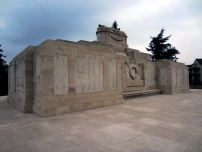| First Name: | George | Last Name: | MARTIN | |
|---|---|---|---|---|
| Date of Death: | 08/10/1914 | Lived/Born In: | Deptford | |
| Rank: | Private | Unit: | East Kent (Buffs)1 | |
| Memorial Site: | La Ferte-sous-Jouarre Memorial, France | |||
Current Information:Born-St Pancras
The Battle of the Aisne 13-28 September, 1914 After the Germans were defeated on the Marne they fell back to the River Aisne, closely pursued by both the British and the French. The new German line was a very formidable defensive position. To attack it meant having to cross the Aisne and then climb up a 500 foot high ridge on top of which was the Chemin des Dames, a road that gave the Germans an easy way to move troops along the top of the hills. On 13th September the Aisne was crossed by both British and French troops but after that progress became slower, until there was no progress at all. Both sides dug in and the fighting settled down into trench warfare. The fighting on the Aisne continued for two weeks at the end of which both sides realised that frontal attacks on entrenched positions were both costly and non-productive, not that this deterred them from continuing with this tactic throughout the war. 6th Division, which included the 1st East Kent (Buffs) battalion of 16 Brigade arrived on the Aisne, just in time to help repel a concerted enemy attack on 21st September, 1914. The battalion then remained in these trenches near Vailly, either in the front line or in support or reserve positions, until the middle of October. On 8th October in very bad weather and harassed by shell fire, 1st Buffs were relieved from some badly knocked about trenches that constituted the front line and moved back to reserve positions. The enemy often seemed to know when an inter-battalion relief was taking place in the front line opposite them and then did as much as they could to disrupt it. This meant targeting the approach communication trenches with their artillery and keeping up a high level of machine-gun and rifle fire. Reliefs therefore were times of extra danger and many a soldier was killed or wounded during them. This may have been the fate of George Martin. |
||||
| « Back to Search Results | ||||
| If you think any of the information shown here is incorrect, Click Here to submit your amends and comments | ||||




